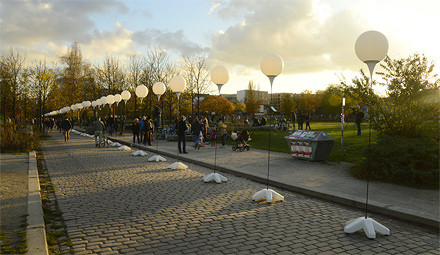
In 1993, as the first phase of Mauerpark’s construction was underway, a cobbled road was uncovered directly beneath where the Berlin Wall stood: this was the former Schwedter Straße. Noting the road’s aesthetic and historical worth, Prof. Gustav Lange, the park’s designer, integrated it into his design, and it became the main pathway in Mauerpark for walkers, runners, and cyclists.
A decade later, the Berlin Senate proposed to pave over the cobbled road with asphalt in order to better integrate it into the two bike paths that run through the area: the Berlin Wall Trail and the long-distance cycling route between Berlin and the island of Usedom, in the Baltic Sea. There were, however, two major problems with the idea of paving over the former Schwedter Straße. First, it would radically alter the historically authentic appearance of the site, which is an important Berlin memorial, and thus park visitors as well as cyclists themselves would lose a valuable link to the site’s past. Second, it would prioritize the long-distance bikers’ wishes over the needs of park users and residents: pedestrians, children learning to ride and other slower riders, and people in wheelchairs. Instead of a pathway for all users, the road would become a bicycle speedway.
On April 4, 2005, the Berlin-Pankow assembly called for modifications to the Berlin Senate’s plans, asserting that there should be “no prioritizing bike traffic above other park users,” and that Mauerpark must “remain a green space with park trails.” Additionally, they invited Freunde des Mauerparks (still operating under the name Freundeskreis Mauerpark) and the Gleim Neighborhood Civic Association—which were already seeking alternitives to the paving plan—to participate in future discussions.
Representatives from the Berlin Senate, the Pankow district government met with Freundeskreis Mauerpark and the Gleim Neighborhood Civic Association on June 8, 2005. The two citizens’ groups presented several alternative proposals, including a wide, paved bike path in the future expansion area of Mauerpark, and an asphalt strip along the current western edge of the park. These proposals, however, were rejected due to lack of funding, and the Senate authorities continued to insist on the plans to pave over the cobbled road. But the Pankow assembly, along with Freunde des Mauerparks and the Gleim Association, remained adamant as well, and the cobbled road still runs through Mauerpark, in need of only very minor repair.

